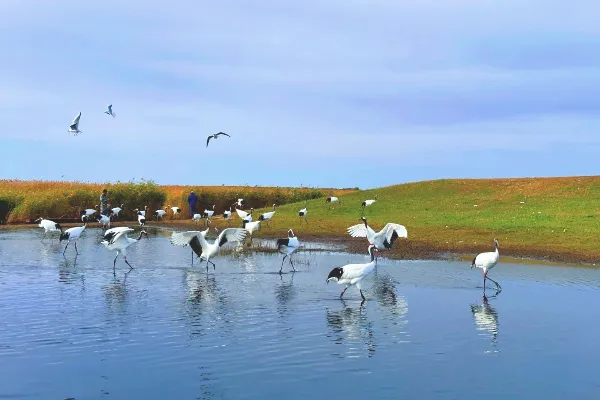
Located in southeast Qiqihar, Heilongjiang Province, Zhalong National Nature Reserve is China's earliest wetland-type reserve, renowned as the "Home of Red-crowned Cranes". Hosting the world's largest wild breeding population of these cranes, it's both a Wetland of International Importance and a National Nature Reserve.
History & Culture
Historical Origins
- Established: Provincial reserve in 1979, upgraded to national level in 1987
- Name Meaning: "Zhalong" derives from Mongolian "Jalun Nur" meaning "wild geese habitat"
- International Status: Listed as Ramsar Site (1992), member of Northeast Asian Crane Site Network (2001)
Cultural Features
- Crane Culture: Red-crowned cranes symbolize longevity in Chinese tradition
- Fishing-Hunting Culture: Preserves ethnic minority lifestyles
- Eco-Culture: Model wetland conservation and ecological education site
Natural Landscapes
Wetland Ecosystem
- Area: 210,000 hectares (core zone 70,000ha)
- Water Systems: Freshwater marshes, reed beds, lakes and meadows
- Vegetation: Dominated by reeds with cattails and water onions
Wildlife Resources
- Bird Paradise: 260+ bird species (1/5 of China's total)
- Crane Kingdom: 6 of world's 15 crane species, including 300+ red-crowned cranes
- Other Fauna: 46 fish, 20 mammal, and 7 amphibian/reptile species
Key Attractions
Must-See Areas
- Crane Observation Deck: Best spot for wild crane release shows
- Wetland Museum: Educational center on wetland ecology
- Nine-Turn Bridge: Wooden walkway through reed marshes
- Crane View Tower: Panoramic overlook for photographers
Signature Scenes
- Cranes Dancing at Dawn: Flocks performing morning dances
- Flying Reed Flowers: Silver reed blossoms in autumn
- Wetland Sunset: Spectacle of birds returning at dusk
Unique Experiences
Eco-Tourism
- Crane Release: Daily wild training sessions (Apr-Oct)
- Birdwatching: Observe white-naped and Siberian cranes
- Nature Photography: Capture rare courtship/nesting behaviors
Seasonal Activities
- Spring: Crane migration (Mar-Apr)
- Summer: Lotus viewing & water chestnut picking (Jul-Aug)
- Autumn: Reed Flower Festival & Wetland Forum (Sep-Oct)
- Winter: Unique snow crane watching (Dec-Feb)
Practical Information
Opening Hours
- Peak Season (Apr15-Oct31): 08:00-17:00
- Off Season (Nov1-Apr14): 09:00-16:00
- Crane Releases: Daily at 10:30/15:00 (+13:30 in peak season)
Tickets
- Adult: ¥65 (includes museum)
- Shuttle Bus: ¥20 (round-trip to core area)
- Discounts: 50% off for students/seniors, free under 1.2m
Transportation
- By Air: From Qiqihar Sanjiazi Airport (1hr drive)
- By Rail: Take Bus 306 from Qiqihar Station (40min)
- By Car: 27km from downtown via Qizha Road
Travel Tips
- Best crane viewing at dawn/dusk when most active
- Bring binoculars, telephoto lens, mosquito repellent
- Do not feed wildlife and maintain quiet observation
- Winter requires extreme cold gear (-30℃ possible)
